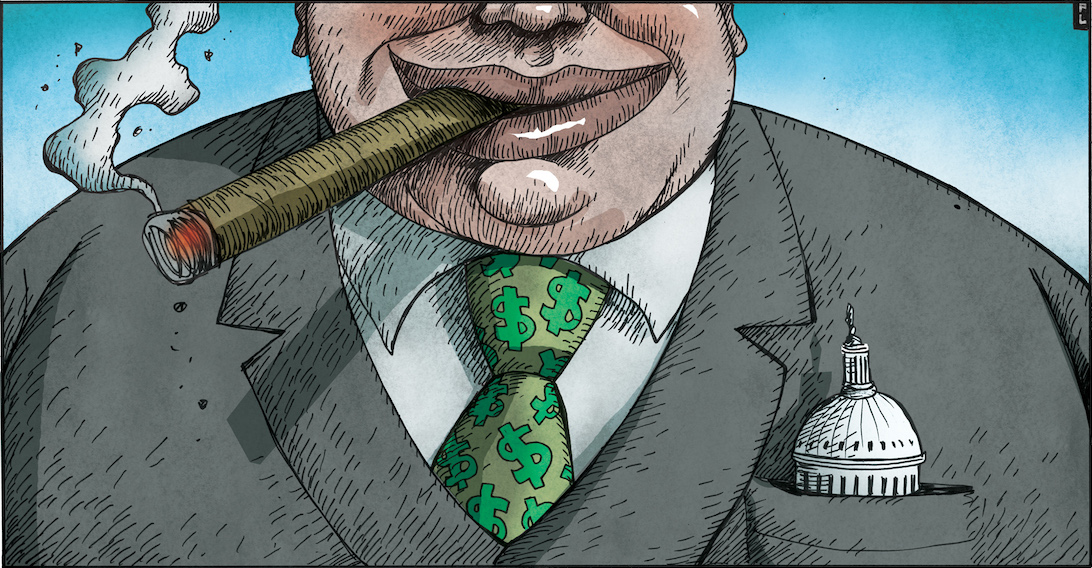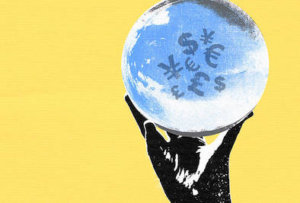Donald Trump’s presidency is a symptom of an interregnum between economic orders – a period that will result in a new balance between state and market. While his administration’s economic policies are unlikely to provide the right answer, they may at least show the world what not to do.
LONDON – Donald Trump’s inauguration as
the 45th president of the United States is widely seen as the beginning of the
end of the post-1945 capitalist order that became globally dominant after the
Cold War’s end. But is it possible that Trumpism is
actually the end of the beginning? Could Trump’s victory mark the end of a
period of post-crisis confusion, when the economic model that failed in 2008
was finally recognized as irretrievably broken, and the start of a new phase of
global capitalism, when a new approach to economic management gradually
evolves?
If history is any guide, the near-collapse of the global financial system in 2008 was always likely to be reflected – after a lag of five years or so – in challenges to existing political institutions and prevailing economic ideology. As I have recently explained – and described in greater detail in my 2010 book Capitalism 4.0– this was the sequence of events that followed previous systemic crises of global capitalism: liberal imperialism followed the 1840s revolutions; Keynesianism followed the Great Depression of the 1930s; and Thatcher-Reagan market fundamentalism followed the Great Inflation of the 1970s. Could Trumpism – understood as a lagged response to the 2008 crisis – herald the emergence of a new capitalist regime?
This question can be divided into three parts:
Can Trump’s economic policies work? Will his administration’s economic program
be politically sustainable? And what impact might Trumpism
have on economic thinking and attitudes to capitalism around the world?
Trickle-Down Redux
On the first of these issues, a few Project Syndicate commentators see some grounds for hope, but most are deeply pessimistic, a stance epitomized by Nobel laureate Joseph Stiglitz. “There really is no silver lining to the cloud that now hangs over the US and the world,” he argues. “The only way Trump will square his promises of higher infrastructure and defense spending with large tax cuts and deficit reduction is a heavy dose of what used to be called voodoo economics.” For Stiglitz, Trump represents a re-enactment of the Reagan era’s socially regressive trickle-down economics, but with the addition of two further lethal ingredients – a trade war with China and a loss of access to health care for millions.
The political consequences, Stiglitz believes, will be disastrous. Experience shows that this trickle-down “story does not end well for Trump’s angry, displaced Rust Belt voters,” who will be tempted to seek even more aggressively for scapegoats once they realize how profoundly Trump has betrayed their interests.
Simon Johnson of MIT Sloan and the Peterson Institute for International Economics reaches a similar conclusion. Trump’s economic-policy priorities are reflected in his proposed cabinet, which represents a dramatic shift to outright “oligarchy: direct control of the state by people with substantial private economic power,” says Johnson. “Trump seems determined to lower income taxes for high-income Americans, as well as to reduce capital-gains tax (mostly paid by the well-off) and nearly eliminate corporate taxes (again, disproportionately benefiting the richest).”
Focusing on the politics of the new administration’s plans, Johnson, a former International Monetary Fund chief economist, notes that Trump leads “a coalition of businesspeople who wrongly believe that protectionism is a good way to help the economy” and “market fundamentalists” who are determined to cut taxes. To consolidate this coalition, the market fundamentalists are embracing protectionism, justifying Trump’s proposed import tariffs as a way to pay for slashing corporate taxes. Tariffs, however, are equivalent to increasing the sales tax. Thus, the result will be to “deflect attention from the essentials of their policy: lower taxes for the oligarchs,” paid for by “higher taxes – not to mention significant losses of high-paying jobs” (as a result of protectionism) – “for almost everyone else.”
Unlike Johnson, Harvard University’s Martin Feldstein, who served as Chairman of President Ronald Reagan’s Council of Economic Advisers, welcomes the prospect of a reduction in top marginal tax rates. President Barack Obama’s policies, Feldstein argues, continued an unhealthy “shift in the tax burden to those with the highest income levels” since the Reagan era.
But while Feldstein favors broadening the tax base away from the richest Americans in a “revenue-neutral way,” he is skeptical about Trump’s signature promises of higher wages, more “middle class” jobs, and stronger economic growth. The “economy has essentially reached full employment, with the unemployment rate at 4.9% in October,” he notes. The tighter labor market has in turn caused consumer prices to “rise 2.2% over the past year, up from 1.9% a year earlier,” while “production workers’ wages rose 2.4%.” Given real wage growth and rising inflation, he sees “no reason to seek an increase in aggregate demand at this time.”
Strange Hopes
As Feldstein’s skepticism demonstrates, Project Syndicate commentators’ views of Trumponomics do not fall neatly along ideological lines. Indeed, the Harvard development economist Dani Rodrik, certainly no market fundamentalist, finds reason for hope in Trump’s opposition to “free trade” deals laden with provisions that have nothing to do with trade. As he puts it, “Adam Smith and David Ricardo would turn over in their graves if they read the Trans-Pacific Partnership,” with the special preferences it offers specific industries and vested interests, and other newer trade agreements that Trump has denounced. All of them “incorporate rules on intellectual property, capital flows, and investment protections that are mainly designed to generate and preserve profits for financial institutions and multinational enterprises at the expense of other legitimate policy goals.”
Thus, while Rodrik deplores Trump’s demagogic politics and his “nonsensical” claims about many of his policies, he hopes that Trump’s election will arrest a trend of hyper-globalization that has been moving faster than can be economically justified. “Economists have long known that market failures – including poorly functioning labor markets, credit market imperfections, knowledge or environmental externalities, and monopolies – can interfere with reaping gains from trade,” he points out. And yet they “have consistently minimized” globalization’s capacity to “deepen societal cleavages, exacerbate distributional problems, and undermine domestic social bargains” – all outcomes that “directly affected communities in the United States.”
The Keynesian economic historian Robert Skidelsky sees other positive features in Trump’s policy ideas – and even in his economic philosophy. “Trump’s protectionism harks back to an older American tradition of a high-wage, job-rich manufacturing [economy that] has foundered with globalization,” Skidelsky says, and even “Trump’s isolationism is a populist way of saying that the US needs to withdraw from commitments which it has neither the power nor the will to honor.”
Most important of all, says Skidelsky, Trump’s proposal of an “$800 billion-$1 trillion program of infrastructure investment,” a “massive corporate-tax cut,” and “a pledge to maintain welfare entitlements” adds up to “a modern form of Keynesian fiscal policy.” As such, Trumpism amounts to a “head-on challenge to the neoliberal obsession with deficits and debt reduction, and to reliance on quantitative easing as the sole – and now exhausted – demand-management tool.”
By reopening debate on such previously taboo issues, Skidelsky concludes, “Trumpism could be a solution to the crisis of liberalism, not a portent of its disintegration.” If so, “liberals should not turn away in disgust and despair, but rather engage with Trumpism’s positive potential.” Trump’s “proposals need to be interrogated and refined,” according to Skidelsky, “not dismissed as ignorant ravings.”
In a similar vein, Kenneth Rogoff cautions against letting disapproval of Trump’s politics overwhelm economic judgment. Trump’s fiscal stimulus and emphasis on deregulation will boost demand in the classic Keynesian manner and are already making some business leaders “ecstatic.” While deregulation will not necessarily “improve the average American’s wellbeing,” and his tax proposals will “disproportionately benefit the rich,” they could make the US economy “move significantly faster, at least for a while.” That’s why “it’s wise to remember that you don’t have to be a nice guy to get the economy going,” Rogoff concludes. “In many ways, Germany was as successful as America at using stimulus to lift the economy out of the Great Depression.”
In my own initial reaction to Trump’s victory, I identified five possible economic benefits that could partly offset the obvious risks of higher interest rates, trade wars, an over-valued dollar, and the regressive distributional effects justifiably criticized by Stiglitz, Johnson, and Rogoff. The most important are the promise of a strong Keynesian growth stimulus, an easing of over-zealous financial regulations that locked many households out of mortgage markets, and some sensible tax reforms, particularly those aimed at encouraging profit repatriation by US companies and broadening the tax base.
Born to Lose
Trump’s success or failure as President may depend less on the evolution of macroeconomic variables such as growth, employment, wages, and tax rates than on the underlying socioeconomic forces that powered his campaign. In considering such forces, some Project Syndicate commentators focus on income inequality, while others emphasize cultural and demographic factors. But all conclude that, as a political program, Trumpism is unlikely to be a viable creation.
If widening inequality and declining middle-class incomes were the main causes of America’s populist revolt, Trumpism will ultimately aggravate, not ameliorate, these grievances. “Real (inflation-adjusted) wages at the bottom of the income distribution are roughly where they were 60 years ago,” Stiglitz noted shortly before the election. “So it is no surprise that Trump finds a large, receptive audience when he says the state of the economy is rotten.”
And yet, for two generations, Stiglitz continues, Democrats and Republicans alike insisted that “trade and financial liberalization” – the key reforms underpinning globalization – “would ensure prosperity for all.” Little wonder, then, that voters “whose standard of living has stagnated or declined” concluded that “America’s political leaders either didn’t know what they were talking about or were lying (or both).”
The dilemma for Trump, Stiglitz maintains, is that while he clearly benefited from “the widespread anger stemming from that loss of trust in government,” his policies will not assuage it. “Surely, another dose of trickle-down economics of the kind he promises, with tax cuts aimed almost entirely at rich Americans and corporations, would produce results no better than the last time they were tried.”
Robert Johnson, President of the Institute for New Economic Thinking, offers another reason why Trump voters aggrieved by widening inequalities of wealth and power are in for a rude awakening. It was no accident, Johnson observes, that during the party primaries, only Trump and Senator Bernie Sanders on the Democratic side “set their sights squarely on what mattered most to voters: a political economy in which elected officials strongly promoted a broad-based prosperity that included them.”
The other candidates, “constrained by a system that makes it extremely difficult to fund a credible political campaign without catering slavishly to the wealthiest sliver of American society,” simply couldn’t go there. “That system invited rebellion,” Johnson argues, “and Trump and Sanders – by self-financing and grassroots fundraising, respectively – were ideally positioned to lead one.”
Now Trump “will need to devise remedies to the social, economic, and political problems that he has described,” Johnson continues. “But to do that, he will have to work within the same ‘rigged’ system that he ran against, and he will have to craft policies that are actually feasible and will have a positive effect on Americans’ lives.” And, because Trump’s fiscal expansion will “again disproportionately benefit the wealthy, without trickling down to the rest of Americans,” disillusionment will set in.
But what if income inequality is not the main reason why swaths of middle-class voters rejected traditional party politics and turned to Trump? What if, as Michael Sandel, the Harvard political philosopher, argues, voters’ “grievances are about social esteem, not only about wages and jobs”?
Edmund Phelps, another Nobel laureate economist, cites data supporting Sandel’s hypothesis. “In fact, since 1970, aggregate labor compensation (wages plus fringe benefits) has grown only a little more slowly than aggregate profits have,” Phelps notes, while “average wage growth at the bottom of the income scale has not slowed relative to the ‘middle class.’” On the other hand, “the average hourly compensation of private-sector workers (production and non-supervisory employees) has grown far more slowly than that of everyone else.” Middle-income white, working-class men in non-supervisory production jobs have suffered the biggest losses.
These are also the workers who have dropped out of the labor force most rapidly, and are most likely to succumb to poor health, suicide, and drug dependence. “These men,” as Phelps puts it, “have lost the opportunity to do meaningful work, and to feel a sense of agency; and they have been deprived of a space where they can prosper, by gaining the satisfaction of succeeding at something, and grow in a self-fulfilling vocation.”
This is, of course, precisely the demographic group that secured Trump’s victory in the battleground industrial states of Iowa, Michigan, Ohio, Pennsylvania, and Wisconsin. Phelps believes that economic opportunities for manual workers in such regions can be restored only if productivity growth is boosted in manufacturing industries by “opening up competition, not just cutting back regulations.” He notes, however, that Trump’s policies of trade protectionism, political “bullying” to preserve existing employment, and tax cuts geared to large corporations are more likely to stifle innovation than to promote it.
The French economist Jean Pisani-Ferry reaches a similar conclusion from a different perspective. Noting that “the past suddenly seems to have much more appeal than the future,” not just in the US, but also in Britain, France, and many other advanced and emerging countries, Pisani-Ferry proposes four explanations: weak economic growth, widening income inequality, technological change that eliminates manual employment, plus a fourth, less familiar factor:
The new inequality has a politically salient spatial dimension. Educated, professionally successful people increasingly marry and live close to one another, mostly in large, prosperous metropolitan areas. Those left out also marry and live close to one another, mostly in depressed areas or small towns. [As a result], US counties won by Trump account for just 36% of GDP, whereas those won by Hillary Clinton account for 64%. Massive spatial inequality creates large communities of people with no future, where the prevailing aspiration can only be to turn back the clock.
In the face of these multifaceted socioeconomic problems, Pisani-Ferry believes that “a sensible agenda must simultaneously address its macroeconomic, educational, distributional, and spatial dimensions.” There is no evidence that Trump’s policy proposals can achieve anything of this kind. On the contrary, whereas Skidelsky cites Trump’s promise not to cut welfare entitlements, congressional Republicans are intent on doing just that. With Trump’s support and encouragement, they have already begun dismantling Obama’s signature health-care reform, the Affordable Care Act, with nothing to replace it – a move that the Congressional Budget Office recently estimated will cause the number of uninsured to rise by 18 million in the first year alone.
Capitalism 4.1?
All of this leads, finally, to the question of how Trump’s presidency is likely to shape global economic thinking and the future of capitalism. Phelps offers a grim prognosis. “American innovation first began declining or narrowing as far back as the late 1960s,” he notes, owing to “a corporatist ideology that permeated all levels of government.” True, “Silicon Valley created new industries and improved the pace of innovation for a short time”; but now “it, too, has run up against diminishing returns.”
Phelps sees the solution in a restoration of the “individualist ideology upon which capitalism thrives” and a revival of America’s “innovative spirit – the love of imagining, exploring, experimenting and creating.” But this, he believes, is not Trump’s agenda. Trump “has rarely mentioned innovation,” Phelps observes, “and his team is considering a dangerous approach that could actually undermine it”: an increase in government intervention, curbs on trade and competition, and “an expansion of corporatist policy the likes of which have not been seen since the fascist German and Italian economies of the 1930s.” But any policy serving to “protect incumbents and block newcomers” will most likely “drive a silver spike into the heart of the innovation process.”
I am more optimistic about the outlook, at least in the very long term. As I wrote last March: “Capitalism is an evolutionary system that responds to crises by radically transforming both economic relations and political institutions. The message of today’s populist revolts is that politicians must tear up their pre-crisis rulebooks and encourage a revolution in economic thinking.”
Trump represents a comprehensive rejection of
the economic thinking that has dominated the world for a generation. Shaping
the new economic thinking will be the most important challenge for both
economists and politicians in the years ahead. In my view, the defining feature
of each successive transformation of global capitalism has been a shift in the
boundary between economics and politics, and between faith in market forces and
reliance on government intervention.
Yoon Young-kwan, a former South Korean foreign minister, makes a similar point. “We are at an interregnum,” Yoon writes. “Populism, nationalism, and xenophobia float on the surface of a larger sea change: a fundamental shift worldwide in the relationship between the state and the market.” Reconciling these two domains of activity “is the central concern of political economy today, just as it was for Adam Smith in the eighteenth century, Friedrich List and Karl Marx in the nineteenth century, and John Maynard Keynes and Friedrich von Hayek in their long debate on the topic through the middle decades of the twentieth century.”
And, indeed, Trump is merely the most acute
symptom of a global phenomenon. “Social and political discontent,” Yoon rightly
notes, “will continue to bubble up around the world until we return the
state-market relationship to a healthy equilibrium.”
The Trump presidency, like anti-establishment upheavals in Europe and elsewhere, will force the entire world to start asking fundamental questions about how the relationship between markets and governments in the next phase of global capitalism should evolve. Under Trump, US economic policies in the next four years are very unlikely to provide the right answer; but his administration may at least show the world what not to do.







